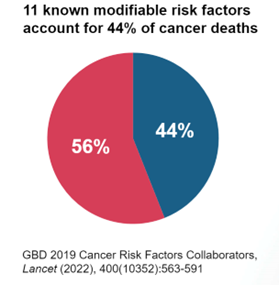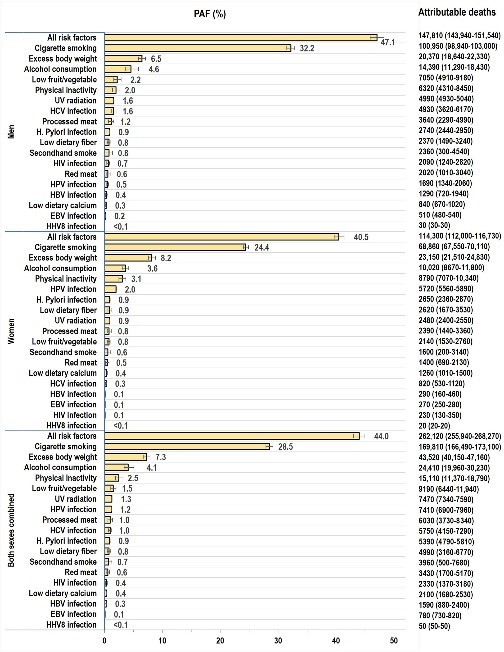Overview
Modifiable risk factors (MRFs) are behaviors and exposures that can raise or lower a person’s risk of cancer. Increased cancer risk associated with MRFs can be influenced through changes to environments, policies, and social norms that influence behaviors and exposures.
MRFs account for a large proportion of cancer incidence and mortality, yet the role of specific risk factors and how combinations of factors influence risk over time is unknown for some cancers. Novel strategies are needed to assess and influence the impact of MRFs across the life course, to effectively intervene at the individual and community levels at critical timepoints, and to design dynamic, multilevel strategies to reduce risk.
Global
 GBD 2019 Cancer Risk Factors Collaborators. The global burden of cancer attributable to risk factors, 2010-19: a systematic analysis for the Global Burden of Disease Study 2019. Lancet. 2022;400(10352):563-591. doi:10.1016/S0140-6736(22)01438-6
GBD 2019 Cancer Risk Factors Collaborators. The global burden of cancer attributable to risk factors, 2010-19: a systematic analysis for the Global Burden of Disease Study 2019. Lancet. 2022;400(10352):563-591. doi:10.1016/S0140-6736(22)01438-6United States
Estimated proportion and number of cancer deaths attributable to evaluated risk factors in adults 30 years and older by sex, United States, 2019.
 Islami F, Marlow EC, Thomson B, et al. Proportion and number of cancer cases and deaths attributable to potentially modifiable risk factors in the United States, 2019. CA Cancer J Clin. 2024; 1-28. doi:10.3322/caac.21858
Islami F, Marlow EC, Thomson B, et al. Proportion and number of cancer cases and deaths attributable to potentially modifiable risk factors in the United States, 2019. CA Cancer J Clin. 2024; 1-28. doi:10.3322/caac.21858The 11 MRFs included in the illustrated estimate of attributable risk are smoking, alcohol use, high body mass index (BMI), unsafe sex, high fasting plasma glucose, ambient particulate matter, occupational exposure to asbestos, diet low in whole grains, diet low in milk, and secondhand smoke. Although broadly similar, other approaches and results for specific countries can differ in their estimates of the most important MRFs. Notably, lack of physical activity is the seventh ranked MRF in the United States but does not appear in the top 11 MRFs based on the Global Burden of Diseases, Injuries, and Risk Factors Study analysis of MRFs globally. The list of the specific MRFs examined and how they are defined will influence the rankings.
Priorities
- Identify research gaps and intervention needs regarding MRFs to mitigate cancer risk.
- Address prioritized data, measurement, and intervention needs for risk factors with greater spatial and temporal alignment across the life course and among specific subgroups.
- Support research that models effects of risk factors and interventions over the life course and across birth cohorts to investigate the impact on risk trajectories, incidence, and mortality.
- Promote use of advanced statistical and computational methods to understand causal pathways of MRFs on variation in cancer risk, response to treatment, and survival.
- Support research to evaluate the effects of built, natural, economic, health care, and policy environments on MRFs clusters and on response to interventions.
- Develop and support an infrastructure for the efficient implementation of trials on behavioral and structural risk factor interventions.
Division of Cancer Control and Population Sciences (DCCPS) and Modifiable Risk Factors
DCCPS engages in diverse activities focused on MRFs, including contributing to the Cancer Trends Progress Report, a series of reports that describe the nation's progress against cancer through research and related efforts. Notable DCCPS branches working in this area include the following
The Modifiable Risk Factors working group was developed as part of the DCCPS six future directions to bring together diverse perspectives from all program areas in the DCCPS portfolio. The working group advances DCCPS’s leadership role in MRFs and cancer studies, research, and advocacy, while building interagency partnerships and finding new and innovative ways of compiling and sharing MRF research.
Tools and Other Resources
Diet
- Automated Self-Administered 24-Hour (ASA24®) Dietary Assessment Tool
- Selected Dietary Assessment Resources (PDF)
Multiple Factors
Physical Activity
- Activities Completed over Time in 24-hours (ACT24)
- National Health and Nutrition Examination Survey (NHANES) Accelerometer
Selected Resources
- Agriculture and Diet: Value Added for Nutrition, Translation, and Adaptation in a Global Ecology (ADVANTAGE) Virtual Meeting Series
- Center for Global Health
- Health Behaviors Research Branch Resources
- National Collaborative on Childhood Obesity Research (NCCOR)
- NIH Community Engagement Alliance (CEAL)
- Nutrition for Precision Health, powered by the All of Us Research Program | NIH Common Fund
- Risk Factors Assessment Branch Resources
- USDA’s USGRCP Climate Change, Food Systems, and Nutrition Security Working Group
Success Stories
- DCCPS Efforts Help to Eliminate Deaths From Cervical Cancer
- Tobacco-Control Strategies Reduce Cancer Mortality Rates
- DCCPS Research Informs Reduced Indoor Tanning and Spurs Decline in Melanoma Incidence
- CISNET Modeling Improves Screening Guidelines
- Epidemiological Research on Hereditary Cancer Syndromes Reduces Cancer Incidence and Mortality for High-Risk Individuals
Funding Opportunities
- NOT-CA-24-073: Notice of Special Interest (NOSI): Factors impacting how Time-Restricted Eating (TRE) influences cancer-related outcomes
Expiration Date: May 8, 2027
- NOT-AA-23-018: Notice of Special Interest (NOSI): Epidemiology and Prevention in Alcohol Research
Expiration Date: September 6, 2026
- NOT-MD-23-002:Notice of Special Interest (NOSI): Addressing the Etiology of Health Disparities and Health Advantages Among Immigrant Populations
Expiration Date: June 6, 2026
- NOT-CA-24-031: Notice of Special Interest (NOSI): Validation of Digital Health and Artificial Intelligence/Machine Learning Tools for Improved Assessment in Biomedical and Behavioral Research
Expiration Date: July 6, 2025
- PAR-22-233: Time-Sensitive Opportunities for Health Research (R61/R33 Clinical Trial Not Allowed)
Expiration Date: March 2, 2025
- NOT-DK-24-014: Notice of Change to Extend Application Due Dates for PAR-21-305 - Time-Sensitive Obesity Policy and Program Evaluation (R01 Clinical Trial Not Allowed)
Expiration Date: January 10, 2025
- NOT-CA-23-037: Notice of Special Interest (NOSI): Technology Development for Cancer Control and Population Science Research
Expiration Date: December 31, 2024
- NOT-OD-22-135: Notice of Special Interest (NOSI): Stimulating Research to Understand and Address Hunger, Food and Nutrition Insecurity
Expiration Date: November 29, 2024
Past Events
- Behavioral Research Program Webinar Series
- Obesity-Related Policy, Systems, and Environmental Research in the U.S. (OPUS) Workshop – June 4-5, 2024
- Agriculture and Diet: Value Added for Nutrition, Translation, and Adaptation in a Global Ecology (ADVANTAGE) – April 2023 to June 2023
- The Role of Structural Racial/Ethnic Racism in the Intersection between Obesity and Cancer Health Disparities – April 12, 2023
- Obesity and Prostate Cancer Risk: Gaps in our Current Understanding, and Thoughts on How to Close the Gaps (Part 2) – March 24, 2023
- Obesity and Prostate Cancer Risk: Gaps in our Current Understanding, and Thoughts on How to Close the Gaps (Part 1) – February 28, 2023
- Exploring the Intersection of Tobacco and Alcohol in Cancer Control, Part 1 – October 13, 2022
- A Deeper Dive into Exercise Interventions to Prevent or Mitigate Cancer Treatment-Related Aging – From Preclinical to Population Science – September 12, 2022
- Current Research and Opportunities in Alcohol and Cancer Survivorship – July 14, 2022
Contacts



